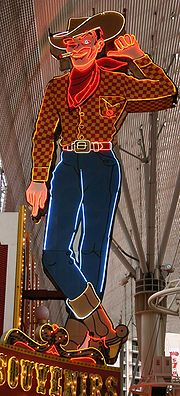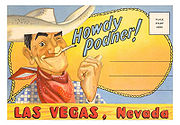
Vegas Vic
Encyclopedia

Las Vegas, Nevada
Las Vegas is the most populous city in the U.S. state of Nevada and is also the county seat of Clark County, Nevada. Las Vegas is an internationally renowned major resort city for gambling, shopping, and fine dining. The city bills itself as The Entertainment Capital of the World, and is famous...
, Nevada
Nevada
Nevada is a state in the western, mountain west, and southwestern regions of the United States. With an area of and a population of about 2.7 million, it is the 7th-largest and 35th-most populous state. Over two-thirds of Nevada's people live in the Las Vegas metropolitan area, which contains its...
neon sign
Neon sign
Neon signs are made using electrified, luminous tube lights that contain rarefied neon or other gases. They are the most common use for neon lighting, which was first demonstrated in a modern form in December, 1910 by Georges Claude at the Paris Motor Show. While they are used worldwide, neon signs...
that resembles a cowboy
Cowboy
A cowboy is an animal herder who tends cattle on ranches in North America, traditionally on horseback, and often performs a multitude of other ranch-related tasks. The historic American cowboy of the late 19th century arose from the vaquero traditions of northern Mexico and became a figure of...
that was erected on the exterior of The Pioneer Club
Pioneer Club Las Vegas
Pioneer Club Las Vegas was a casino that opened in 1942 and was located in Downtown Las Vegas, Nevada, at 25 East Fremont Street. It ceased operating as a casino in 1995, the same year the Fremont Street Experience was completed.-History:...
in Las Vegas in 1951. The sign was a departure in graphic design from typeface based neon signs, to a friendly and welcoming human form of a cowboy. The sign's human-like abilities of talking and waving its arm constituted an immediate acceptance as the unofficial welcoming sign reproduced thousands of times over the years and all over the world. The sign is currently owned by Schiff Enterprises and can still be found at 25 E Fremont Street, where he has been since 1951 on the exterior of what used to be The Pioneer Club but is currently a souvenir shop also owned by Schiff Enterprises.
History

Pat Denner
Pat Denner is the designer of Vegas Vic. In 1951, the Young Electric Sign Company in Salt Lake City commissioned Mr. Denner to design an illustration for the manufacturing of the neon sign...
, who modeled it after the image in use by the Las Vegas Chamber of Commerce. The neon version was complete with a waving arm, a moving cigarette, and a recording of "Howdy Podner!" every 15 minutes. Vegas Vic was then erected on the exterior of the Pioneer club in 1951 on the southwest corner of First Street and Fremont Street
Fremont Street
Fremont Street is a street in Las Vegas, Nevada, and is the second most famous street in the Las Vegas metropolitan area after the Las Vegas Strip...
replacing the sign that simply said Pioneer Club with an image of a horse drawn covered wagon.
In 1966, Lee Marvin
Lee Marvin
Lee Marvin was an American film actor. Known for his gravelly voice, white hair and 6' 2" stature, Marvin at first did supporting roles, mostly villains, soldiers and other hardboiled characters, but after winning an Academy Award for Best Actor for his dual roles in Cat Ballou , he landed more...
was filming The Professionals and staying at the Mint Hotel
The Mint Las Vegas
The Mint Las Vegas was a hotel and casino in downtown Las Vegas, Nevada. Opened in 1957, a 26-story hotel tower was added in 1965. In 1988, The Mint was sold and became part of Binion's Horseshoe....
. Marvin complained that Vegas Vic was too loud, so casino executives silenced Vegas Vic and it was left that way for nearly two decades. The speaking was restored in the 1980s, but as of 2006 no longer works. The arm stopped waving in 1991.
When the Fremont Street Experience
Fremont Street Experience
The Fremont Street Experience is a pedestrian mall and attraction in downtown Las Vegas, Nevada. The FSE occupies the westernmost 5 blocks of Fremont Street, including the area known for years as "Glitter Gulch," and portions of some other adjacent streets.The attraction is a barrel vault canopy,...
was under construction in 1994, several feet were cut off of the brim of Vegas Vic's hat to make him fit properly under the curve of the canopy of the Fremont Street Experience. After the Pioneer Club closed in 1995, Vegas Vic fell into disrepair. The Neon Museum at the Fremont Street Experience
Neon Museum at the Fremont Street Experience
The Neon Museum in Las Vegas, Nevada, United States, features signs from old casinos and other businesses displayed outdoors on over . The museum is restoring the La Concha Motel lobby as its visitor center....
stepped in and offered to restore and maintain the sign if Schiff Enterprises, who owned the building and the sign, paid for the electric bill to operate it. Under the proposal, Schiff Enterprises would retain ownership of the sign until they sold the building. If they sold the building then it would become the property of the Neon Museum who would then maintain it from that point on. Schiff Enterprises declined the offer and eventually restored the sign themselves.

Vegas Vic was the first of what would become three neon cowboys at Nevada casinos. Wendover Will
Wendover Will
Wendover Will is a sign created for the Stateline Casino in West Wendover, Nevada in 1952. It is now a landmark for the town of West Wendover.-History:...
was erected a year later in 1952 at Stateline Casino
Stateline Casino
Stateline Hotel and Casino was located in West Wendover straddling the Nevada/Utah border.- History :The owner of Stateline Casino was William "Bill" Smith, who started his business in 1926 as a service station. In 1931 when gambling was legalized in Nevada, Smith expanded his service station...
and River Rick
Pioneer Hotel & Gambling Hall
The Pioneer Hotel & Gambling Hall is a hotel and casino in Laughlin, Nevada known for its neon cigarette-puffing River Rick marque. It used to be a sister property of Pioneer Club in Las Vegas until both properties sold to separate parties.-History:...
was erected in 1981 at the Pioneer Hotel & Gambling Hall
Pioneer Hotel & Gambling Hall
The Pioneer Hotel & Gambling Hall is a hotel and casino in Laughlin, Nevada known for its neon cigarette-puffing River Rick marque. It used to be a sister property of Pioneer Club in Las Vegas until both properties sold to separate parties.-History:...
in Laughlin
Laughlin, Nevada
Laughlin is a census-designated place in Clark County, Nevada, United States, and a port located on the Colorado River. Laughlin is south of Las Vegas, located in the far southern tip of Nevada. It is best known for its gaming, entertainment, and water recreation. As of the 2010 census, the...
. River Rick is virtually an identical copy of Vegas Vic, outfitted with a different color scheme.
Vegas Vic has received new paint schemes through the years. Originally, from the 50's through the 60's, his shirt was white with yellow checkered stripes. Later during an early restoration in the 70's, his shirt was painted solid yellow. When he was restored in 1998 his shirt was painted a red and yellow checkered pattern.
In Popular Culture
- The Securitron who first guides the player in Fallout: New VegasFallout: New VegasFallout: New Vegas is a first person action role-playing video game in the Fallout series developed by Obsidian Entertainment, and published by Bethesda Softworks. The game is based in a post-apocalyptic environment in and around Las Vegas, Nevada...
has a face on his television screen "face" that resembles Vegas Vic, as is his name is Victor.
See also
- Stardust sign
- Welcome to Fabulous Las Vegas signWelcome to Fabulous Las Vegas signThe Welcome to Fabulous Las Vegas sign is a Las Vegas Strip landmark funded in May 1959 and erected soon after by Western Neon. The sign was designed by Betty Willis at the request of Ted Rogich, a local salesman, who sold it to Clark County, Nevada....
- Wendover WillWendover WillWendover Will is a sign created for the Stateline Casino in West Wendover, Nevada in 1952. It is now a landmark for the town of West Wendover.-History:...

